Lecture 3: Medieval Bodies
1/12
There's no tags or description
Looks like no tags are added yet.
Name | Mastery | Learn | Test | Matching | Spaced |
|---|
No study sessions yet.
13 Terms
Historical context
Time period: 500-1500 CE (6th-16th century)
BUT this lecture focuses on the late European Middle Ages (1200-1500 CE)
Traditional focus on Europe
Increasing persecution of sodomia
Role of objects/art:
(1) Could be complicit in their persecution
(2) BUT can serve as a space in which narrative subjects were NOT always subjects to the same scorn
Why study the medieval body?
Misconceptions about the Medieval body
(1) Aesthetically different appearance/stylisation
E.g. vs. focus on the human form, naturalism & musculature in the Renaissance (14th-17th century)
Medieval bodies aesthetically judged as simplistic/ugly
BUT this is due to artists having different priorities compared to other periods (e.g. vs. humanist spirit in the Renaissance)
(2) Medieval European objects tend to foreground hegemonic subjects (e.g. white Europeans)
BUT if you know how to look at them correctly, they make way for the study of sexual, gender & racial minorities
Apparent subversions of these systems (e.g. the gender binary) were an integral part of medieval Christianity & its images
Medieval people ARE their (depicted) bodies
We can tell a lot about their personality, occupation, gender, status etc. from their illustrated body
Especially depictions of bodies that were betwixt & between, changed/actively changing
Late medieval artists participated in & shaped a society-wide fascination w/ all that bodies could become
Played an active role in shaping bodies to their own liking ⭐
To reflect the desires, longings & fantasies that shaped their very being
= made claims to the kinds of bodies & desires that mattered and which did not (whether through omission or outright condemnation)
How to study the medieval body?
Artists making bodies
Reading: Karl Whittington
Queering an object/image
The body of the artist in physical relation to the bodies (objects) they are making
Objects making bodies
Reading: Diane Wolfthal
Objects that shape relationships between bodies
The comb as an object potent w/ power & sexuality
Entanglement of the secular & the sacred
E.g. even courtly love images are infused w/ medieval Christianity
Attending directly to the visual language of bodies
Fluidity/mutability of bodies
Different types:
- Internal
- External
Different causes: in particular, desire
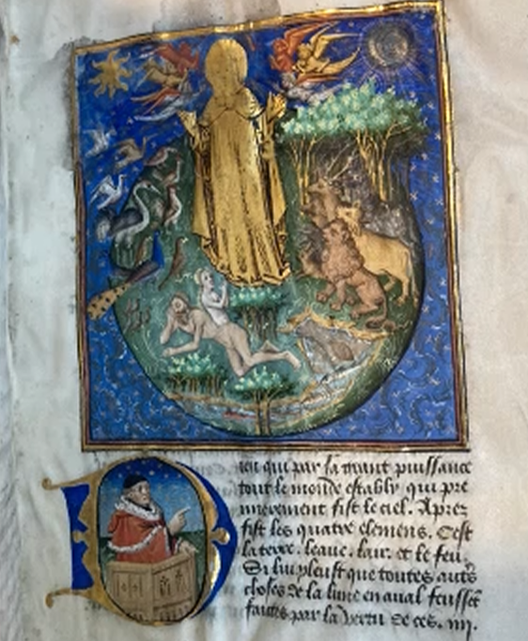
Provenance & Historical context
Régime du corps manuscript: Creation of Adam and Eve (ca. 1440-50)
Provenance
Image is the frontispiece of the Régime du corps
Very popular household medical compendium
1st medical treatise written in a vernacular language (NOT in Latin)
For a European audience
Historical context
Theory of the 4 humours
The human body is composed of 4 humours
(1) Blood (= sanguine)
(2) Yellow bile (= choleric)
(3) Black bile (= melancholic)
(4) Phlegm (= phlegmatic)
The 4 humours informs:
(1) Health
(2) Temperament
(3) Personality/behavioural attitudes
(4) The quality of a person’s body (hot/cold, dry/moist)
Science of complexion
Balance of 4 humours —> skin colour —> health
Tied to:
(1) Gender
E.g. European women = cold & moist, depicted as white vs. European men = hot & dry, depicted as darker
(2) A tool of racist thinking
The ‘wrong’ colour (e.g. pale, black, green) can be a sign of bad health
Can be a sign of ‘bad habits, a lack of sense and a bad nature’
E.g. belief that black women had a stronger sex drive as they had darker skin like European men
The human body is in a constant state of change as it’s impacted by the humours
Explains the science of physiognomy to help humans ‘care for the health that God gave them’
Attentive readers will learn ‘how one can, by nature, know man & woman from the outside’
= medical lesson (learning how to read bodies & understand the type of care they require) is also a lesson in reading visual images
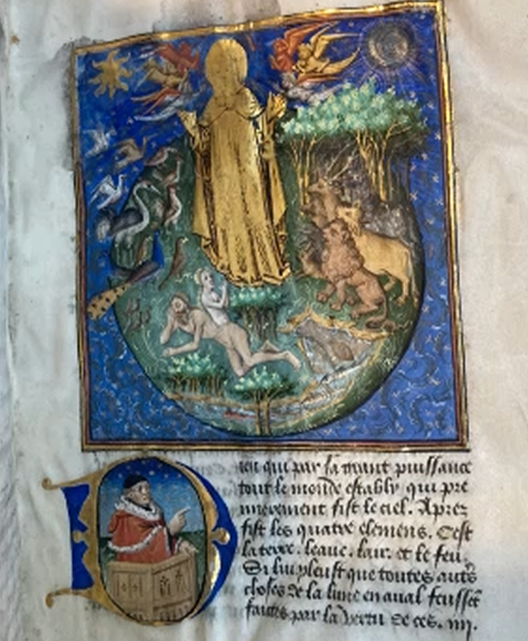
Description, Analysis & Interpretation
Régime du corps manuscript: Creation of Adam and Eve (ca. 1440-50)
Description
Depicts the moment when God creates Eve out of Adam’s side ribs when he is fast asleep
Adam has already been created from the slime of the Earth
Adam is sleeping w/ his head in his hand
Aldobrandino (creator of the text) painted below in the frontispiece
Standing in a pulpit
Wearing a lavish ermine coat
Pointing at the text
Analysis
Hybrid body
Sexually differentiated to some extent (e.g. Eve has breasts)
BUT more or less share the same lower body
= perfect androgyny? Or monstrous body?
Adam & Eve suspended on the precipice of change
Their shared body as a ground zero for the creation & care of all human bodies (albeit white, European & Christian perspective)
Devotion to God precedes bodily integrity
Eve joins her hands in alert prayer even w/ her body half-formed
Parallel between Aldobrandino (creator of the text) & God (creator of humans)
Sense of authority
Interpretation
The frontispiece participates in the construction of religious & medical knowledge
Aspects of the illustration could be read subversively ⭐
(1) The first humans are figured as an intersex body in all its beauty
(2) Eve doubles as an image of the possibly female reader OR the patron Beatrice of Savoy
Who took on the roles of Aldobrandino & God in her own efforts to create & care for her family (4 daughters)

Provenance (3)
Base for a Statuette (ca. 1470-80)
South Netherlandish. Now in the Cloisters Collection
Provenance
Made of boxwood (popular carving medium at the time)
Likely had a statue of the Virgin Mary on top (similar South Netherlandish statue in the V&A)
May have been inspired by the Cloisters carving
Virgin Mary depicted as breastfeeding
The breast put to work in different ways
Mary understood as the new Eve
Through the incarnation of Christ, Christ was able to redeem all mankind for this original sin caused by Adam & Eve
Depicts the events after the creation of Adam & Eve (‘The Fall’)
A serpent tempts Eve to eat the forbidden fruit from the Tree of Knowledge
She shares the fruit w/ Adam
= the act of original sin; Adam & Eve transition from a state of innocence → carnal knowledge & sin
Their bodies undergo a physical change ⭐
Want to start using their body in lustful ways (NOT just for the purposes of reproduction)
Transformation of their bodies implies the transformation of all future bodies
= Christians thereafter possess the same wayward desires & a weakened will to resist them
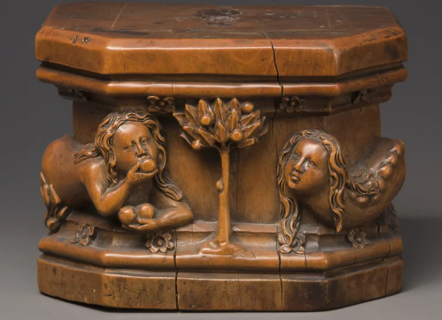
Analysis (4)
Base for a Statuette (ca. 1470-80)
South Netherlandish. Now in the Cloisters Collection
Tree of Knowledge w/ fruit in the middle
Apples morph into Eve’s breasts
Positioning of hands holding 2 apples before her chest
Eve’s lips put over the apple (which doubles as a breast)
= highly eroticised treatment of the breast
Artist is playing w/ sight lines
From the front, we see 2 figures w/ longer hair = ostensibly female
When you turn the sculpture, a serpentine body is revealed
Snake looks almost identical to Eve
They not only have a similar face & hair
Eve’s body, from the side, is also snakelike
= almost mirror images of each other
In Hebrew tradition, Adam’s 1st wife Lilith is the female-headed serpent
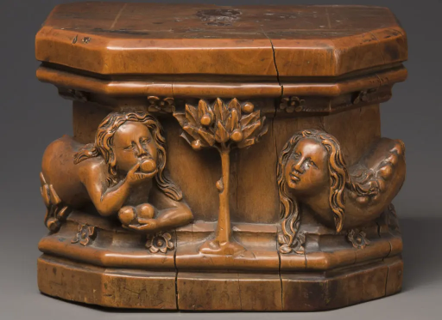
Interpretation (3)
Base for a Statuette (ca. 1470-80)
South Netherlandish. Now in the Cloisters Collection
Desire as a disruptive force that can change bodies irrevocably
Extra misogynistic reading of biblical narrative
A female serpent tempts female eve to eat the apple
Causes the fall of all of mankind
Condemns particular kinds of lust associated w/ the Fall
(1) Desire for oneself
(2) Same-sex desire
Fall under a broad category of sins called sodomia
Both understood as one and the same in medieval thought
Any kind of sexual position/sex act that was NOT reproductive
Belief that the cause of sodomia is the fall, specifically Eve’s perverse female desire
Such images can help us ‘catch glimpses of the acts, relationships and people who remain unnamed’
Can paradoxically prompt us to seek out & recover people precisely because of its condemnation of same-gender desire
E.g. LGBT individuals in the past, their lives, and how they suffered/were punished
Serve as a powerful reminder of the ways that objects can be complicit in the marginalisation & physical violence towards sexual & gender minorities
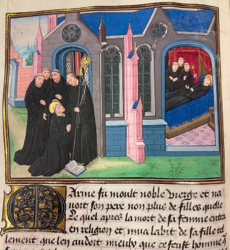
Saint Marin(e), Golden Legend (1445-1465)
Belgium
Historical context
>30 saints changed their social sex & gender presentation over the course of their lifetime
Artists embraced their representation
Almost all F>M
Perhaps more socially acceptable due to the misogynistic idea that they are undergoing a kind of ascent (it’s better to become male)
Provenance
The Golden Legend
A compendium of saints’ lives
Circulated throughout Europe (bestseller)
Narrative of Saint Marin(e)
Noble virgin
Assigned female at birth
At some point their mother dies, and their father decides to join a monastery
Marin(e) wants to go with their father
To do this, they have to get a monastic tonsure (male monk haircut)
They enter the monastery as a monk
Eventually their father dies
Local innkeeper’s daughter accuses Marin(e) of impregnating her
Marin(e) gets kicked out of the monastery
Doesn’t try to defend themself
Eventually Marin(e) dies
Monks preparing their body
Realise that Marin(e) has female genitalia
Analysis
Left: Marin(e) kneeling in front of an episcopal judge who holds a crozier
Before an open doorway
Being asked to leave the monastery
Right: Marin(e) lying on their deathbed, with monks preparing their body
Fully clothed
Still wearing monastic habit
Parted curtain at the top could suggest some revelation about Marin(e)’s body
Text: pronouns switch back and forth between male & female
The artist had only one spot to create an image that complements the text = likely intentional in its creation
The artist has specifically privileged the saint’s desire to be seen as male
Even if it breaks w/ iconographic tradition & risks narrative confusion
By avoiding the ‘big reveal’ moment showing Marin(e)’s bare body (visual deadnaming)
Interpretation
Visual narrative can also offer a world in which the transgression of a gender binary was NOT subject to persecution
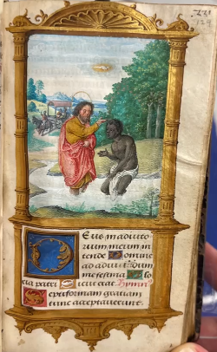
Philip the Deacon baptizes Simeon Bachos (the “Ethiopian eunuch”) (1533)
Belgium, probably Brussels
Provenance
Book of Hours
Narrative of Simeon Bachos
Originates from the acts of the Apostles
Philip is traveling from Jerusalem to Gaza
Encounters the Ethiopian eunuch, Simeon
Who is reading from the book of Isaiah
Philip explains the meaning of the text to Simeon
Simeon then asks to be baptised
Analysis
At the moment of conversion
Philip & Simeon’s bodies underscore their multiple differences
Skin: Simeon’s black skin
Physical reality: epidermal race
Other qualities of a person: hermeneutic race
E.g. Emphasises geographic origin
E.g. the fact that they’re not Christian yet
Clothing: Simeon almost fully nude
Invites more visual attention on his black skin
Sexualises him - cloth gathers around his genitalia, large piece of white cloth in his hand call attention to his genital region
Which also marks him as different as he’s understood to be a eunuch
Posture: Philip stands tall, Simeon bends his knees & hunches his back
= clear imbalance of power
Interpretation
The black body as a rhetorical tool
Black
Not quite yet castrated
Participates in the construction of Philip’s own body & identity
As male, Christian & European (although he was actually from the Middle East)
While bodily transformation here is consensual
This representation suggests that Simeon’s body, upon becoming Christian, becomes a better one
Philip visualises this ideal
Karl Whittington, “The Cluny Adam: Queering a Sculptor’s Touch in the Shadow of Notre-Dame,” Different Visions: New Perspectives on Medieval Art 8 (2022)
Background
Queering medieval art
Since the 1990s
(A) Analysing a work “whose themes straightforwardly included sexuality/gender”, OR
(B) Using a deconstructive methodology based in queer + feminist literary studies to explore an art object whose themes were NOT explicitly sexual/gendered
Goals:
Exploring a wide range of interpretations embodied by objects > seeking to pin down particular historical identities
To bring identity & experience to bear
To expose the structures of gender & power informing art creation
Unique context of premodern art
Most artists/makers are anonymous
Vs. later periods: artworks are more often understood to be expressions/extensions of self
= easier to make meaning from issues of identity
Ovid’s Pygmalion
The sculptor fell in love w/ the statue he had carved
Prayed to Aphrodite that it be brought to life
Carved out of ivory
BUT manuscript paintings show him working in a scale only possible w/ stone
Life-size figure makes the erotic connection more plausible & palpable
Story was incredibly popular during the 13th & 14th centuries
Emphasised the intimate connection between sculptor & sculpture
Chisel as a phallic extension of the sculptor’s body
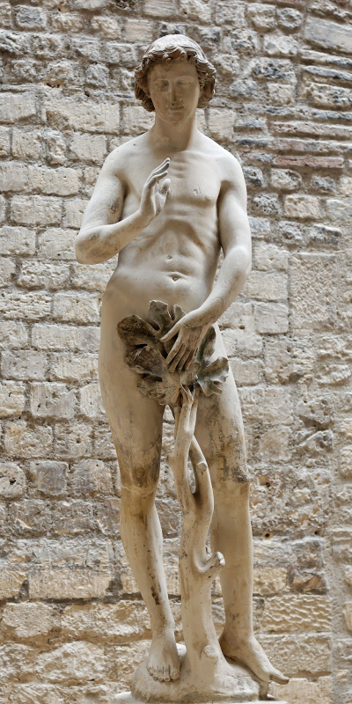
Karl Whittington, “The Cluny Adam: Queering a Sculptor’s Touch in the Shadow of Notre-Dame,” Different Visions: New Perspectives on Medieval Art 8 (2022)
Provenance
Statue of Adam from Notre-Dame in Paris (1260)
(1) Was part of a sculptural program that once ornamented the interior south transept of Notre-Dame
Program also included a Christ in Judgement and a counterpart sculpture of Eve
The loss of Eve is significant
Did the sculpture also contain key erotic areas that remained unfinished?
Was she also carved w/ the same softness & sensuality?
Was every part of both the front & back highly finished?
New layer of psychic engagement (complex bisexuality) in the sculptor’s role
E.g. if she lacked the evident eroticism of the Adam, may be read as evidence of the sculptor’s greater interest in Adam
Either due to queer attraction OR an identification w/ the figure
E.g. if her eroticism was even more pointed than the Adam’s, the opposite could be argued
(2) Was damaged in the French revolution
(3) After a series of sales/displays in museums, ended up in the Cluny Museum (1887)
Analysis of creation
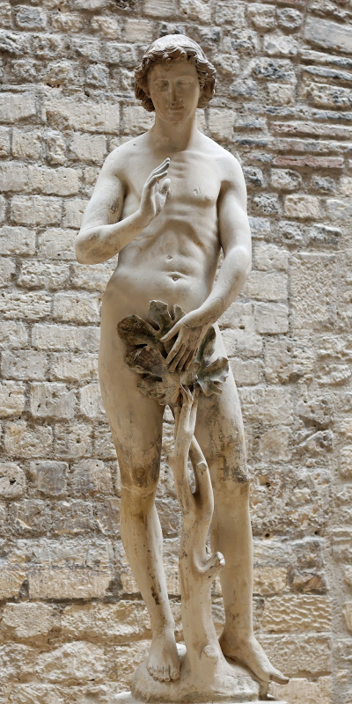
Karl Whittington, “The Cluny Adam: Queering a Sculptor’s Touch in the Shadow of Notre-Dame,” Different Visions: New Perspectives on Medieval Art 8 (2022)
Visual analysis
Statue of Adam from Notre-Dame in Paris (1260)
Original display
Adam & Eve in 2 niches
Adam to the right of Christ, Eve to the left
Adam & Eve would have been viewed from far below
Possibly could have been slightly angled toward Christ at the center
Adam’s head angled slightly down towards the viewer
= responds to this arrangement
Monumental freestanding nude
One of the only ones known
2 metres tall
While nude figures exist (uncommonly) in medieval sculpture, they are usually in a much smaller scale
Not actually nude
Genitalia covered by the leafing tree
Held in place by the left hand
Courtly & graceful
Long limbs
Narrow shoulders
Relaxed, confident
Calm, even features
Eroticism/sensuality
Reflects casual, confident eroticism of classical Greek & Roman nudes
Vision of fallen sexuality
Covered genitalia
YET shame is not truly conveyed by the figure ⭐
Sense of agency & intellect conveyed by Adam’s firm press of the fig lead against his groin
Must have been inspired at least in part by a classical Roman work
Monumental nudity
Sinuous suggestion of contrapposto
S-curve to the body
Sculptor’s complicated investment in the beauty of the body
Abdomen has musculature yet a softness more associated at the time w/ female figures
Buttocks carved fully in the round ⭐
Unusual in depictions of men at this time
Esp. when the sculpture was meant to be placed against a wall
Buttocks are significantly less polished & at a lower degree of finish compared to rest of body
Clear chisel marks remaining across this entire area
Vs. full completion on upper back & legs
Buttocks were not extensively restored
= suggests an unwillingness/discomfort w/
undertaking extensive periods of time to
sand & polish this part of the body?
Seems to have abandoned either out of frustration, annoyance, discomfort, or embarrassment